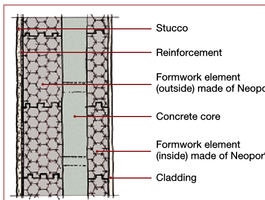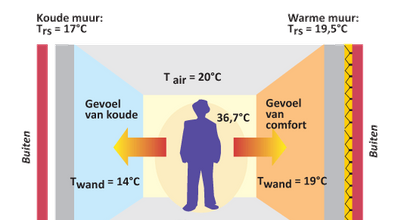Thermal Inertness
After reading all the literature, studies and posts on various construction forums, I have to admit that, like you, I probably got a headache.
To find out the answer, I turned to the services of the BBRI.
Mr Timo Demets has formulated the answer in a very clear and understandable language for the layman.
Timo De Mets - WTCB :
Concerning the thermal inertia, a first tip I can give: don't read too much on internet forums, there are unfortunately a lot of inaccuracies being told there.
As you can see, there are two aspects to 'Thermal inertia', namely
Thermal inertia on the outside
Thermal inertia on the inside".
We must clearly distinguish between these two phenomena of thermal inertia:
Timo De Mets - WTCB :
Thermal inertia on the outside.
Based on the principle that solar heat that shines on the wall is stored and later emitted to the inside.
Only if the wall is not insulated will a part, and only a small part, of the solar heat be transferred to the inside; and this is not even necessarily positive, because
- this is absolutely outweighed by the heat losses of non-insulated buildings.
In summer, this will cause your building to heat up even more, with overheating as a possible consequence.
So as soon as you insulate the wall even slightly, the heat transfer to the inside is completely negligible.
Virtually all the heat absorbed by the outer shell will be transferred back outside, causing the so-called urban heat island effect.
Moreover, it is mainly through the windows, and not through the walls, that solar heat enters.
Let it be clear, for the indoor climate, thermal inertia on the outside plays a negligible role (certainly for your insulated 'EcoBriq®' building blocks).
Thermal inertia on the inside.
This is a more important issue, especially with regard to overheating in summer.
In heavy buildings, the heat that comes in (typically through the windows) is first stored in the walls, so it stays cool inside longer; lightweight buildings, on the other hand, have little mass, so the air temperature will rise faster.
If I'm not mistaken, the concrete core of the "Strongbau" block is not accessible (surrounded by insulation), making the thermal mass inaccessible/difficult to address.
But thermal inertia is only one of the ways to prevent overheating - indeed, if thermal inertia alone is used, there is a very good chance that you will experience overheating problems.
Research by the BBRI has shown that efficient external shading and intensive night ventilation have a greater impact on summer comfort than the presence of inertia.
Translated with www.DeepL.com/Translator (free version)
Our opinion
We will take a closer look at the subject of 'Thermal Inertia'.
The outer walls themselves can be considered as 'Thermally Inert'.
The concrete core, which is the supporting structure of the construction, is wrapped in a Neopor® 'fleece' on both the inside and outside.
Depending on whether the construction of the inner walls is done with quick-fit concrete/lime sandstone/wood or ICF blocks, the 'Thermal Inertia on the Inner Side' will be somewhat influenced.
The same goes for the type of floor plate that is chosen: concrete floor plate or an EPS floor plate, in the latter case the 'Thermal Inertia' will also decrease.
A house completely built with ICF products is considered to be 'Thermal Inertia Neutral' or no Thermal Inertia and is comparable with 'Timber Frame Construction'.
Is this a disadvantage in summer?
The heat from the sun entering through the windows, with or without blinds, does not heat up the walls insulated on the inside.
What only needs to be cooled is the heated air!
When does the air in a room heat up?
The answer is simple: when the sun shines.
What do we need when the sun shines ?
Cooling: the energy is now provided by Solar energy that is now abundant via solar panels/pans.
This solar energy can now be used directly to provide energy to the ventilation system Type D+, supplemented with built-in air conditioning.
So you catch 3 birds with one stone :
- during the day, thanks to the built-in airco, a pleasant indoor climate.
- free of charge thanks to solar energy
- at night, cooling is often unnecessary (outside temperature drops).
Is this a disadvantage in the winter?
The advantages of a perfectly insulated and airtight home are well known.
Strongbau® and Isobriq® take the prize for their insulation values.
Ecobriq : With a wall thickness of 42.50cm the following insulation values are achieved:
UEQ (W/m²K) = 0.10 and REQ (m²K/W) = 9.964
Isobriq® : With a wall thickness of 40.00cm the following insulation values are achieved:
UEQ (W/m²K) = 0.116 and REQ (m²K/W) = 8.62
As far as thermal inertia is concerned, in summer as in winter, we follow the same logic:
- In summer: what does not heat up must not cool down.
- In winter: what does not cool down must not heat up.











































